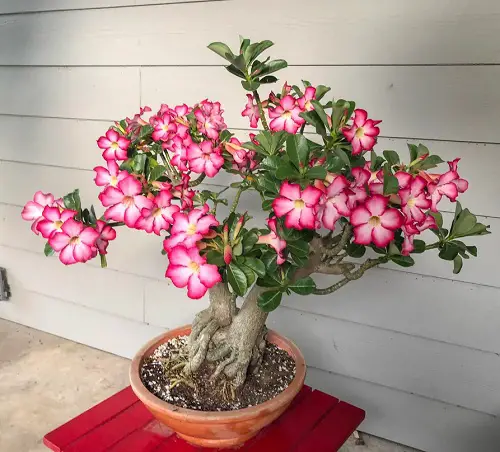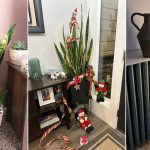Desert Rose Care is extremely rewarding because of its beautiful blooms and engaging structure—keep reading for the helpful tips!
Adenium obesum looks like a bonsai plant, thanks to its thick trunk, which is like icing on the cake. The plant is fairly easy to grow provided you maintain it right. Here are some great Desert Rose Care tips that’ll help you to keep it thriving all year round!
Desert Rose Plant Information
The desert rose isn’t actually a rose—it’s part of the milkweed family, making it a relative of plants like frangipani and oleander. Straight from the dry regions of Africa and the Arabian Peninsula, this tough succulent wins hearts with its thick, sculptural trunk and vibrant flowers that come in shades of deep red, pink, and pure white.
But here’s what makes it truly special—even as a young plant, it doesn’t shy away from blooming! It can flaunt its colorful flowers on slender stems while standing just a few inches tall. Add its tolerance for occasional neglect, and you’ve got the perfect plant for beginners and busy plant parents.
Though often admired for its exotic flowers, it’s also gaining attention for its bioactive compounds, like cardiac glycosides, which scientists are exploring for medicinal uses.
Note that this beauty is toxic if ingested, so be sure to keep it away from curious kids and pets.
Botanical Name: Adenium obesum
Other Names: Adenium, Kudu, Impala lily, Sabi star, Mock azalea
USDA Zones: 9-12
Desert Rose Plant Propagation
Propagating a desert rose can be done through seeds or stem cuttings, and both methods are straightforward—but this applies only to non-hybrid varieties.
If you’re starting with seeds, plant them in a shallow tray filled with a well-draining soil mix, lightly covering them with soil. Mist the surface and keep the tray in a warm, sunny spot. And with a little patience, seedlings will sprout in about a week, rewarding you with new life.
However, take note that hybrid varieties of Desert Rose do not grow true to type from seeds. If you want an identical hybrid plant, propagating through stem cuttings is the way to go. Additionally, hybrid varieties often do not produce seeds at all, which makes cuttings even more important!
For those opting for stem cuttings, select a healthy stem and cut it at an angle using clean shears. Allow the cut end to dry for a couple of days to form a callus, which prevents rotting. Once ready, plant the cutting in sandy, well-draining soil and water lightly. Position it in bright, indirect light, and in a few weeks, roots will develop, giving you a brand-new desert rose to cherish.
Choosing a Container
The size of the pot depends on the plant’s size. Keeping it root-bound will result in more flowers. Terra-cotta is an excellent choice for pots as it provides air circulation for the roots. For stability, choose a container that’s wide and low compared to the tall and thin ones.
If you love the tree look of the desert rose, bonsai pots are an excellent option. Alternatively, ceramic pots in vibrant colors can also complement its beauty. Plastic pots are also a practical choice if you’re looking for an affordable and lightweight option.
Requirements for Growing Desert Rose
Location
Being a succulent tropical plant, it loves to bask in the direct sun and will benefit significantly from 7-8 hours of direct sun per day. So place it in a spot where it receives direct sunlight.
Keep in mind that Desert Rose plants cannot tolerate heavy rainfall or overly wet conditions. If you live in a rainy region, ensure they are placed in a covered area to keep them dry.
Temperature
In hot tropical regions where the temperature ranges from 70-100°F (21-38°C), it can stay outdoors all year long. Don’t worry if you live in a colder region where the temperature drops as low as 45°F (7°C) as it produces a lot of flowers in such regions. You’ll just have to move it back indoors when the temperature drops below 40°F (4°C).
Interesting Fact: While this plant can handle scorching summer heat like a pro, it doesn’t get along with frost. If exposed to freezing temperatures, its stems can turn mushy—a telltale sign of frost damage. Just keep it cozy and dry during winter to avoid this.
Soil
As long as the soil is light and drains well, desert rose is going to stay happy! Opt for a succulent or cactus soil mix with a gritty and light texture for the best growth. You can also enrich the soil with compost and organic matter at the time of planting.
Remember to avoid using heavy or clayey soil since it holds too much water, which can lead to root rot. Adding pumice or coarse sand will improve drainage and keep your plant healthy.
Watering
It is a drought-tolerant specimen that stores water in its thick stems, which saves you from watering it repeatedly. Infrequent and occasional watering is best when the soil turns dry to the touch. It turns dormant in harsh winters and might even shed leaves so reduce watering in winters.
Desert Rose Care

Fertilizer
Apply a balanced liquid fertilizer, diluted to a quarter of its strength, every month in spring and summer is ideal for promoting growth. If you’re using granular fertilizer, feed the plant once every 3 months. The plant turns dormant in winter and does not require any sort of feeding.
Extra Tip: For more colorful blooms, use a phosphorus-rich fertilizer in early spring. This nutrient encourages the production of large, colorful flowers.
Pruning
Pruning not only shapes the plant but also stimulates new growth. You might even notice more flower buds forming after a good trim. Using wires can help bend and reposition the branches to achieve an interesting shape and size. Also, don’t forget to remove dead and decaying parts of the plant!
Pests and Diseases
Mealybugs, aphids, spider mites, and scales can cause some trouble for desert rose, but apart from that, the plant is mostly disease-free. Root rot commonly occurs when it’s allowed to sit in standing water for too long. It may show signs of wilting if not planted in soil fit for cacti or succulents.
After adding all these tips and facts to your care routine, your Desert Rose will not only thrive but also become the envy of your gardening friends. Don’t forget to share your experiences in the comments below—what’s your favorite thing about the Desert Rose?











